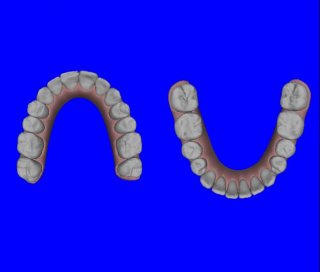"Interproximal stripping" is the dentist removing some enamel from in between the teeth with some nasty diamond grit covered floss. I hate it with a passion, as my teeth are very sensitive, but I need more space for my teeth to move in. Apparently this isn't too damaging to the teeth, as it's in between them, not on the biting surface, and I get some heavy duty fluoride treatment afterward. This gives me enough room for my teeth to slowly move with having to have teeth extracted or headgear. This is only because my teeth aren't too terribly out of alignment to begin with.
I usually hide away in a restroom somewhere if I'm eating in public to take them out. Sometimes I just put a napkin up to my face and swiftly pop them out, but this only works during the second week of wear, when they're more maneuverable. I don't think they're entirely invisible, and I don't really care. It's just much easier to keep my teeth clean with these than it would be with regular braces.
I'm paying $5000 of my own money. I read the National Health doesn't cover it in the UK. Alot of private insurance elsewhere doesn't cover it, either. I don't know much about insurance, though, so you'd have to check it out with your provider.
Here's some info I pulled from this page:
http://www.dentistry.com/pbrightersmile.asp
"Appropriate Treatment: Invisalign® has been helpful in treating adult patients that present with mild to moderate spacing (1-6mm), mild to moderate crowding (5-8mm), and narrow dental arches (4-6mm). All appropriate candidates should be referred by general dentists to an orthodontist for treatment planning. Correct treatment should produce an attractive smile and a correct bite.
Inappropriate Treatment:
Children should not be treated using Invisalign®. Patients must have permanent teeth and the jaws must be growing at the same rate. Adults with multiple missing teeth, tooth decay, gum disease, Craniomandibular Disorder (formerly TMJ), erupting permanent teeth, mixed dentition, or short clinical crowns should not be treated using Invisalign®. Patients with severe crowding, deep bites, open bites, tipped teeth, unidirectional movement of an entire dental arch, or closure of a posterior open bite will all require traditional braces. Invisalign® is not recommended for patients that require multiple tooth extractions, elastics to be placed during treatment, orthognathic surgery, and other existing conditions. Invisalign® should not be used to treat some teeth while other teeth are simultaneously being treated with traditional braces. The aligners cannot lift teeth or aid tooth eruption."
I had to teach myself a bit of dental lingo, and I looked at a bunch of before and after pictures, plus talked to other patients who've had it. The company that makes them is based in Santa Clara County here in the Bay Area close to where I live, so loads of vain Californians such as myself have them here.
Again, talk to a dentist or orthodontist! Google a bunch of words like "invisalign", "orthodontics", "malocclusion classes", "proclination", do an image search and marvel at all the directions one's teeth can point in---but that's all the advice I can give you. Best of luck and I hope this info helps!



 I have Invisalign too, since last summer. Just on my top teeth. I had braces twice when I was younger, once for 3-ish years as a child, then again at 18 for almost a year because my teeth had moved back. By the age of 20 my teeth had moved back again and I decided to switch orthodontists, cause this guy kind of sucked.
I have Invisalign too, since last summer. Just on my top teeth. I had braces twice when I was younger, once for 3-ish years as a child, then again at 18 for almost a year because my teeth had moved back. By the age of 20 my teeth had moved back again and I decided to switch orthodontists, cause this guy kind of sucked.
